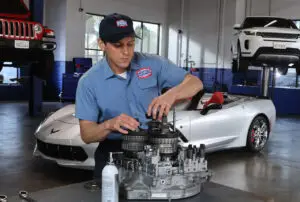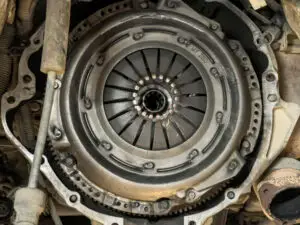At the center of your car’s performance lies the transmission. Without it, power can’t make it from the engine out to the drive wheels, leaving you stuck. The efficiency and longevity of your transmission depends on regular maintenance—and not just on the system itself. Each of your car’s essential systems work together to keep efficient power flow, optimize operating temperature, and improve handling while you drive. That means a routine maintenance schedule that benefits your transmission’s lifespan includes several services related to different systems.
Keep Top Efficiency with Transmission Maintenance
A healthy transmission comes down to maintaining adequate fluid and slowing wear, ultimately impacting performance and preventing overheating. Always consult your owner’s manual for specific recommendations from your car’s manufacturer—however, there are some routine services you should plan to schedule regularly and key benefits of keeping up with them.
Routine Fluid Replacement or Flushes to Prevent Wear & Damage
One of the most important components in your transmission is the fluid. Not only does it pressurize the system, helping facilitate gear shifts in automatic transmission vehicles, but it also lubricates moving parts, preventing excess wear. This dual function is key to extending the life of your transmission and optimizing its performance. Plan to schedule transmission fluid replacements roughly every 50,000 miles, though some vehicles may need it more or less often.
Help Prevent One of the Worst Transmission Problems: Overheating
When it comes to underlying causes of catastrophic damage, overheating is one of the most common. An overheating transmission can come from insufficient or old transmission fluid, but there are other possible causes, too. If you see your engine temperature rising, there’s a good chance your transmission is also running too hot. Overheating can lead to increased gear damage, rough performance, or transmission failure, depending on the severity and how long it’s been going on.
Each Inspection Helps You Stay Ahead of Major Repairs
Annual inspections allow your mechanic to assess the overall performance of your transmission and catch any issues before they escalate. Whether or not you’ve noticed signs of trouble, these regular inspections are key to keeping your transmission efficient and improving its longevity. The longer issues continue, the more likely you are to deal with costly or catastrophic transmission repairs.
Transmission Longevity Relies on the Health of Several Systems
It’s important to keep more than just the transmission itself healthy and efficient. Other systems are closely connected to the transmission and its operation, including the engine, cooling system, and suspension components. By keeping each of these systems in good operating condition, you’ll also help your transmission’s longevity.
Keep Up with Oil Changes & Tune-Ups for Engine Health
One of the most important maintenance services for your engine is regular oil changes. Adequate fresh oil helps optimize engine efficiency, slow wear and tear, and prevent overheating. In addition, regular tune-up services help ensure fuel combustion takes place properly, including checking the spark plugs and fuel injectors. Because these two systems work closely with one another, problems in the engine can increase wear or damage in the transmission, especially over a prolonged period.
Schedule Routine Cooling System Maintenance

The role of your car’s cooling system is to help maintain a healthy operating temperature for the engine. Because the engine and transmission are directly connected, if one overheats, the other also may. Ensure there’s always adequate coolant in the system and schedule annual inspections by a professional mechanic to help catch issues early. This will help extend the life of both your engine and transmission.
Ensure Proper Wheel Alignment & Prevent Suspension Issues
Routine suspension system maintenance includes wheel alignment services annually or every 12,000-15,000 miles. Not only does this help with overall performance and handling on the road, but it also prevents excess strain on the transmission, which can lead to wear or damage. When your car’s wheels are out of alignment, it not only makes steering more difficult, but it also increases strain on the transmission due to increased resistance.
Don’t Discount the Impact of Your Driving Habits
Though routine maintenance goes a long way toward improving your transmission’s longevity, it’s also important to understand the impact of your driving habits. If you frequently tow or haul heavy loads, it’s even more crucial that you keep up with annual inspections of your transmission. City driving with stop-and-go traffic, aggressive acceleration, and improper shifting can all increase wear and tear in or damage to the transmission.
AAMCO’s Chicagoland Mechanics are Here to Help with Your Auto Maintenance Needs
We’re the best in the industry when it comes to transmission care, repair, and diagnostics. Our expert mechanics can help extend the life of your transmission by catching issues early and handling thorough repairs to stop problems in their tracks. For help with your vehicle, head to your local AAMCO—schedule your appointment with us today!
For more tips on keeping your car running smoothly, check out our post on Essential Car Maintenance Tips.=






